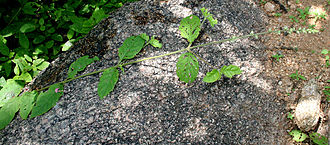Caryophyllales





Caryophyllales is an order of flowering plants that includes a diverse group of families and species, characterized by unique features such as the presence of betacyanins, a type of pigment that replaces anthocyanins in most of these plants, leading to red or violet colors in their tissues. This order is significant both ecologically and economically, encompassing everything from garden plants and crops to wild species that inhabit a range of environments.
Characteristics[edit]
Caryophyllales are known for their distinctive morphological characteristics, which include:
- The presence of betacyanins for red and violet pigmentation, unique to this order.
- A wide variety of growth forms, from herbaceous plants to shrubs, trees, and even succulents.
- Flowers with a fixed structure, often having five petals, five sepals, and a superior ovary.
- Adaptations to diverse environmental conditions, including arid environments where many members exhibit xerophytic traits.
Taxonomy[edit]
The taxonomy of Caryophyllales has undergone significant revisions with the advent of DNA sequencing technologies. It includes both core Caryophyllales and families that have been moved into or out of the order based on genetic evidence. Major families within Caryophyllales include:
- Caryophyllaceae (the pink or carnation family), known for their ornamental value.
- Amaranthaceae, which includes both important food crops like quinoa and ornamental plants.
- Cactaceae, the cactus family, adapted to extremely arid environments.
- Chenopodiaceae, including many salt-tolerant species and important crops such as beets and spinach.
Ecology[edit]
Caryophyllales species are found in a wide range of habitats, from deserts to tropical rainforests. They play crucial roles in their ecosystems, serving as food sources for a variety of animals and contributing to the structure of plant communities. Their ecological diversity is matched by their economic importance, with many species used in agriculture, horticulture, and traditional medicine.
Economic Importance[edit]
Several Caryophyllales families contain species of significant economic importance:
- The Caryophyllaceae family includes popular ornamental plants such as Dianthus (carnations), which are widely cultivated for their beauty and fragrance.
- Amaranthaceae includes crops like Amaranthus (amaranth), known for their nutritious seeds and leaves.
- Cactaceae members are important in the horticultural industry and also play a role in traditional medicines and foods in their native ranges.
Conservation[edit]
Many Caryophyllales species are under threat from habitat destruction, overharvesting, and climate change. Conservation efforts are crucial to protect these species, many of which are endemic to specific regions and have limited distributions. Conservation strategies include habitat preservation, seed banking, and the regulation of trade in endangered species.

Ad. Transform your life with W8MD's Budget GLP-1 injections from $75


W8MD offers a medical weight loss program to lose weight in Philadelphia. Our physician-supervised medical weight loss provides:
- Weight loss injections in NYC (generic and brand names):
- Zepbound / Mounjaro, Wegovy / Ozempic, Saxenda
- Most insurances accepted or discounted self-pay rates. We will obtain insurance prior authorizations if needed.
- Generic GLP1 weight loss injections from $75 for the starting dose.
- Also offer prescription weight loss medications including Phentermine, Qsymia, Diethylpropion, Contrave etc.
NYC weight loss doctor appointmentsNYC weight loss doctor appointments
Start your NYC weight loss journey today at our NYC medical weight loss and Philadelphia medical weight loss clinics.
- Call 718-946-5500 to lose weight in NYC or for medical weight loss in Philadelphia 215-676-2334.
- Tags:NYC medical weight loss, Philadelphia lose weight Zepbound NYC, Budget GLP1 weight loss injections, Wegovy Philadelphia, Wegovy NYC, Philadelphia medical weight loss, Brookly weight loss and Wegovy NYC
|
WikiMD's Wellness Encyclopedia |
| Let Food Be Thy Medicine Medicine Thy Food - Hippocrates |
Medical Disclaimer: WikiMD is not a substitute for professional medical advice. The information on WikiMD is provided as an information resource only, may be incorrect, outdated or misleading, and is not to be used or relied on for any diagnostic or treatment purposes. Please consult your health care provider before making any healthcare decisions or for guidance about a specific medical condition. WikiMD expressly disclaims responsibility, and shall have no liability, for any damages, loss, injury, or liability whatsoever suffered as a result of your reliance on the information contained in this site. By visiting this site you agree to the foregoing terms and conditions, which may from time to time be changed or supplemented by WikiMD. If you do not agree to the foregoing terms and conditions, you should not enter or use this site. See full disclaimer.
Credits:Most images are courtesy of Wikimedia commons, and templates, categories Wikipedia, licensed under CC BY SA or similar.
Translate this page: - East Asian
中文,
日本,
한국어,
South Asian
हिन्दी,
தமிழ்,
తెలుగు,
Urdu,
ಕನ್ನಡ,
Southeast Asian
Indonesian,
Vietnamese,
Thai,
မြန်မာဘာသာ,
বাংলা
European
español,
Deutsch,
français,
Greek,
português do Brasil,
polski,
română,
русский,
Nederlands,
norsk,
svenska,
suomi,
Italian
Middle Eastern & African
عربى,
Turkish,
Persian,
Hebrew,
Afrikaans,
isiZulu,
Kiswahili,
Other
Bulgarian,
Hungarian,
Czech,
Swedish,
മലയാളം,
मराठी,
ਪੰਜਾਬੀ,
ગુજરાતી,
Portuguese,
Ukrainian